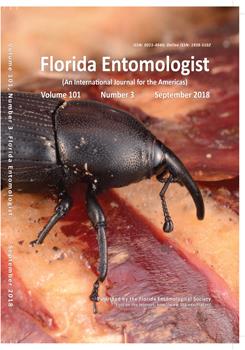Phytonemus pallidus was found in organic strawberry crops in 2 municipalities in the state of Minas Gerais. The sparse information about this pest in the country indicated that P. pallidus had been observed previously only on grapes in southern Brazil. The presence of this pest in the country is relatively new, although in the USA and in some European countries it is already well known due to the economic losses it causes. The report of the occurrence of this herbivore, as well as the affected crops, is essential for the official institutions to take appropriate measures to prevent dispersion to other states. Future studies should be directed to the search for effective alternatives for the management of this pest, because currently there are no insecticides registered for control in Brazil. An alternative that could be considered is biological control.
Phytonemus pallidus (Banks) (Acari: Tarsonemidae), also known as cyclamen mite, is a phytophagous mite commonly associated with strawberry crops in several countries, where it infests young leaves, flowers, and fruits of plants (Smith & Goldsmith 1936; Alford 1972; Easterbrook et al. 2001; Petrova et al. 2002; Berglund et al. 2007; Gobin & Bangels 2008; Tuovinen & Lindqvist 2010). Severe infestations of P. pallidus lead to a reduction in the development of petioles, which become brown or brittle, and results in dwarfing of the strawberry plants (Smith & Goldsmith 1936; Croft et al. 1998; Fadini et al. 2004).The infested fruits are reduced in size and brownish in color, and are unsuitable for harvest (Pallini et al. 2002; Gobin & Bangels 2008).
In Brazil, strawberry is a very important crop due to the economic return it generates (Antunes et al. 2007). The leading producing states are Minas Gerais, Rio Grande do Sul, and São Paulo (IBGE 2006; Antunes et al. 2007; Henz 2010). There are several pests and diseases that attack strawberry crops in Brazil; however, to date, there are no reports of P. pallidus in this crop, although it has been reported on grapes and cyclamen (Moraes & Flechtmann 2008; Oliveira Andrade-Bertolo et al. 2013).
In 2 strawberry-producing localities in the municipalities of Ervália and Canaã (20.842778°S, 42.675306°W and 20.706853°S, 42.648578°W, respectively), we found strawberry plants with the typical symptoms caused by P. pallidus: brownish leaves and fruits, and an apparent reduction in size (Fig. 1B). We monitored the plants in greenhouses at both localities for several wk (from Nov 2014 until Mar 2015). The estimated losses caused by P. pallidus ranges from 22 to 50% of strawberry yields (Alford 1972; Stenseth & Nordby 1976); however, we observed losses of 100% in production due to the attack of this pest in Minas Gerais (personal observations) (Fig. 1A).
During the monitoring period, we collected plant material (leaves and fruits) and packed the material into paper bags for transport to the laboratory, where further analysis was performed. The fruits and leaves were examined at 5× under a stereomicroscope (Stemi 2000 Zeiss, Göttingen, Germany). We observed mites in different stages of development (eggs, juveniles, and adults) on both leaves and fruits, with more individuals observed on the latter (Fig. 2A, B, C). Additionally, adults were observed walking on the surface and in the crevices of the fruits.
To confirm the species identity, individuals were collected, mounted on slides, and sent to a specialist. After analysis by a taxonomist (A. C. Lofego) based on morphological characteristics, it was identified as P. pallidus. Diagonostic features observed in females were: stigmata located post-laterally and very close to seta v1; sejugal apodeme not visible; post-sternal apodeme reduced; seta pl” (spike) absent in tarsus II; apodeme 4 extending postero-lateral relative to the base of seta 3b; tergite setae (c1, c2, d, e, f, h) with similar sizes, between 8 and 12 mm, except for c1, which is thin, smooth, whereas the others are slightly thickened and serrated (Fig. 2D, E, F).
The failure of P. pallidus being reported earlier in the principal strawberry-producing areas in Brazil does not necessarily mean it was not present. Here we report the presence of this mite infesting and causing severe losses to growers in Minas Gerais. We believe that in the future more attention should be paid to the presence and possible economic losses caused by P. pallidus in other strawberry-producing areas in Brazil.
The severity of the attack of P. pallidus on strawberry crops around the world is unquestionable. The key management approach for P. pallidus management is the acquisition and planting of strawberry plants that are free of the pest. Once P. pallidus is established in strawberry crops, its suppression is more complex due to its tendency to seek refuge under the calyxes or within the crevices of the fruits, where they are less conspicuous and somewhat protected from insecticides. Furthermore, no commercial acaricide is registered for the control of P. pallidus in Brazil. For this reason, the search for alternative methods of control that are compatible with organic farming systems should be considered as a priority measure. The use of natural enemies for the management of P. pallidus on strawberry crops in Brazil could constitute a sustainable alternative, because this approach is already being practiced in other countries (Smith & Goldsmith 1936; Huffaker & Spitzer 1951; Huffaker & Kennett 1956; Stenseth & Nordby 1976; Croft et al. 1998; Easterbrook et al. 2001; Petrova et al. 2002; Tuovinen & Lindqvist 2010).
Acknowledgments
We are grateful to Minas Gerais Research Support Foundation - FAPEMIG (Project number APQ-00479-16), Coordination for the Improvement of Higher Education Personnel (CAPES), and National Council of Science and Technological Development (CNPq), Econtrole Research & Consulting Ltda., and to strawberry growers José Vanderley Rezende Ferreira and Henrique Leandro Machado. Author HEVA was supported by the Students-Postgraduate Agreement Program - PECPG, CAPES / CNPq – Brazil, and author AP by FAPEMIG and CNPq.







